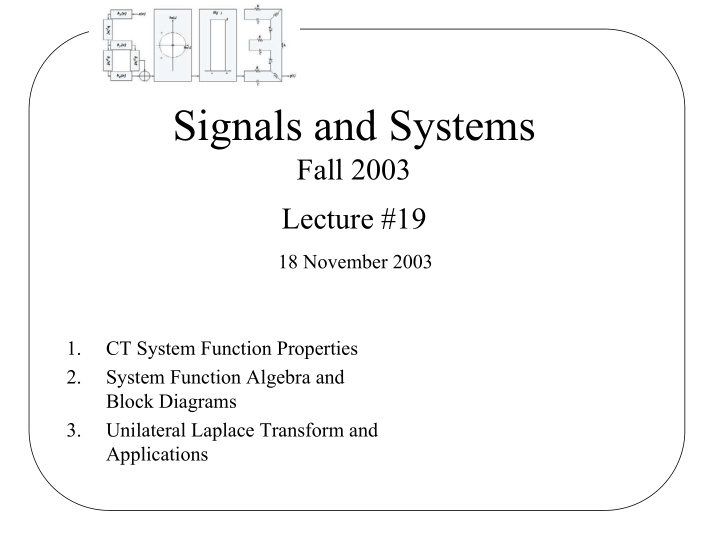



Signals and Systems Fall 2003 Lecture #19 18 November 2003 1. CT System Function Properties 2. System Function Algebra and Block Diagrams 3. Unilateral Laplace Transform and Applications
CT System Function Properties H(s) = “system function” ⇔ ROC of H ( s ) includes j ω axis ∞ 1) System is stable ⇔ ∫ | h ( t ) | dt < ∞ −∞ 2) Causality ⇒ h ( t ) right-sided signal ⇒ ROC of H ( s ) is a right-half plane Question: If the ROC of H ( s ) is a right-half plane, is the system causal? Ex. Non-causal
Properties of CT Rational System Functions a) However, if H ( s ) is rational, then The system is causal ⇔ The ROC of H ( s ) is to the right of the rightmost pole b) If H ( s ) is rational and is the system function of a causal system, then ⇔ The system is stable j ω -axis is in ROC ⇔ all poles are in LHP
Checking if All Poles Are In the Left-Half Plane Method #1 : Calculate all the roots and see! Method #2 : Routh-Hurwitz – Without having to solve for roots.
Initial- and Final-Value Theorems If x ( t ) = 0 for t < 0 and there are no impulses or higher order discontinuities at the origin, then Initial value If x ( t ) = 0 for t < 0 and x ( t ) has a finite limit as t → ∞ , then Final value
Applications of the Initial- and Final-Value Theorem For • Initial value: • Final value
LTI Systems Described by LCCDEs roots of numerator ⇒ zeros roots of denominator ⇒ poles ROC =? Depends on: 1) Locations of all poles. 2) Boundary conditions, i.e. right-, left-, two-sided signals.
System Function Algebra Example: A basic feedback system consisting of causal blocks More on this later in feedback ROC: Determined by the roots of 1+ H 1 ( s ) H 2 ( s ), instead of H 1 ( s )
Block Diagram for Causal LTI Systems with Rational System Functions Example: — Can be viewed as cascade of two systems.
Example (continued) H ( s ) Instead of 1 2 + 4 s − 6 x(t) y(t) 2 + 3 s + 2 2 s s We can construct H ( s ) using: Notation: 1/ s — an integrator
Note also that Lesson to be learned: There are many different ways to construct a system that performs a certain function.
The Unilateral Laplace Transform (The preferred tool to analyze causal CT systems described by LCCDEs with initial conditions ) Note: 1) If x ( t ) = 0 for t < 0, then 2) Unilateral LT of x ( t ) = Bilateral LT of x ( t ) u ( t- ) 3) For example, if h ( t ) is the impulse response of a causal LTI system, then 4) Convolution property:If x 1 ( t ) = x 2 ( t ) = 0 for t < 0, then Same as Bilateral Laplace transform
Differentiation Property for Unilateral Laplace Transform Initial condition! Derivation: Note:
Use of ULTs to Solve Differentiation Equations with Initial Conditions Example: Take ULT: ZIR — Response for ZSR — Response for zero state, β=γ= 0, initially at rest zero input x ( t )=0
Example (continued) Response for LTI system initially at rest ( β = γ = 0) • Response to initial conditions alone (α = 0) . • For example:
Recommend
More recommend